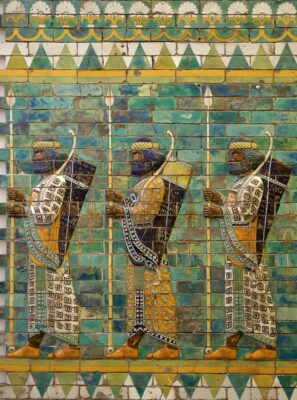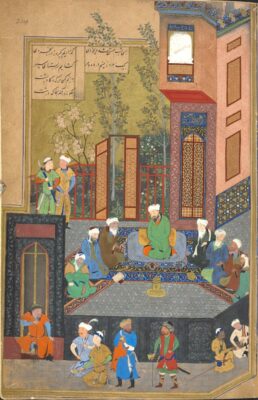Arte de Persia y el Irán antiguo
Un lenguaje por encima del tiempo
“…Pues aunque Goethe recordara en sus poemas del Libro de Zulaika que el inventor de la poesía irania había sido Bahram Gor el sasánida, lo cierto es que ésta vivía ya en los ajuares de las tumbas de Susa, los bronces luristanos, las columnas aqueménidas o la plata de los sasánidas. Y hablaba un lenguaje maravilloso por encima del tiempo. El de su propia realidad.”
Joaquín Córdoba Zoilo, profesor titular de Historia de Oriente Antiguo de la Universidad Autónoma de Madrid (UAM)
Imágenes: Relieve con guerreros aqueménidas en el Museo de Pérgamo de Berlín. Foto de Jakub Hałun — Kamal-ud-din Bihzad: Miniatura del Iskandarnama, 1495.
El actual Irán es un país extenso, con una gran variedad de paisajes y climas, desde la depresión mesopotámica en el golfo Pérsico, las llanuras junto al Mar Caspio, y la enorme meseta central, rodeada por imponentes montañas. No es de extrañar, pues, que a lo largo de la historia haya sido hogar de una gran variedad de pueblos, dando lugar a una rica y variada producción artística.
En el territorio del actual Irán se encuentran ejemplos de arte rupestre prehistórico, tempranos ejemplos de arte sumerio del periodo Uruk (4000 – 3100 a.C.), exquisitas figuras de bronce de la Edad del Hierro en Luristán, imponentes esculturas de la época aqueménida, parta y sasánida, y alfombras y miniaturas de comienzos del periodo islámico, así como las coloridas pinturas del arte Qajar.
Situado en el corazón de las grandes rutas comerciales de la antigüedad, como la Ruta de la Seda, el antiguo Irán estuvo en permanente contacto con otros pueblos o civilizaciones. Así, la influencia de otras culturas, como la mesopotámica, la de los invasores mongoles, o incluso la china y mediterránea, fue decisiva a la hora de marcar la evolución del arte de Irán y Persia.
G. Fernández · theartwolf.com
Follow us on:


